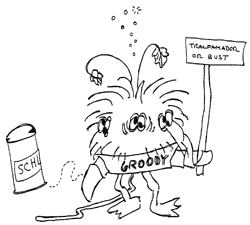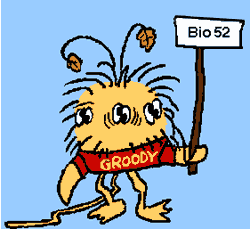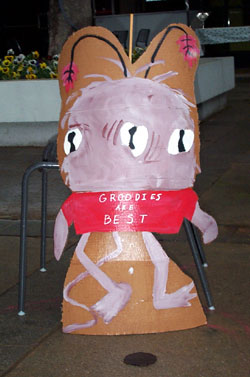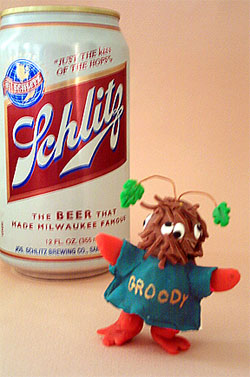Dr. Purves’ Groodies
The Story of Groodies…
Groodies were introduced at Harvey Mudd by Bill Purves, the founding father of the HMC Bio Department. The Biology 52 Homework Book from 1980 is subtitled “Tales of Groodies, Raging Elephants, and Noble Cucumbers”, and the opening sentence is, “Welcome to the wonderful world of Groodies”.
The first Groody homework problem in Bio 52 began:
While traveling with HMC’s Bates Time-Warp Program, you find yourself stranded in a far-off galaxy, a long time ago. To pass the time you pop open a can of Schlitz — and are dismayed when two (2) tiny creatures leap into the beer. Faster than you can imagine, 32 similar creatures climb out of the beer and shake themselves dry. Over the next several weeks you learn many things about these Groodies. (You suspect that they are called Groodies because each one wears a T-shirt with “Groody” written on it in microscopic letters.) Groodies are the dominant local life form; their principal activities are the manufacture of T-shirts and of beer. The beer is essential for their reproduction — a couple of Groodies (one of each sex) dive in together and produce 32 progeny . . . .
But the evolutionary origin of Bio 52 Groodies predates even the original Bio 52 Homework Book by about a decade. As Prof. Purves explains in the preface,
A heart-felt acknowledgment: I confess that I did not invent the name “Groody,” which by the way is pronounced “grew-dee”, NOT “grow-dee”. Groodies first appeared in a fine but commercially unappreciated book by Burton Guttman (Biological Principles, W.A. Benjamin, Inc., New York, 1971). On page 136 of that book, Guttman had a bunch of drawings of strange little critters (see figure below), captioned, “The little creatures shown here are groodies; they are useful (but unfortunately fictional) little organisms that are pure genetic tools. We will use them in parallel with phage to illustrate the basic concepts . . . .” When I read the preface of Guttman’s book (just as you are for some unknown reason reading this preface), I learned the ultimate source of the name: “My daughter Erica is responsible for the name groodies. . . .”

Anyhow, I think my Groodies are handsomer. I thank Dave Gonda, HMC ’79, for the original, definitive drawings of Groodies. . . .
The first Bio 52 Groodies only appeared in Mendelian genetics problems, but today we have problems on the molecular biology, biochemistry, and evolution of Groodies as well as classical Groody genetics. Who knows where they’ll show up next!



